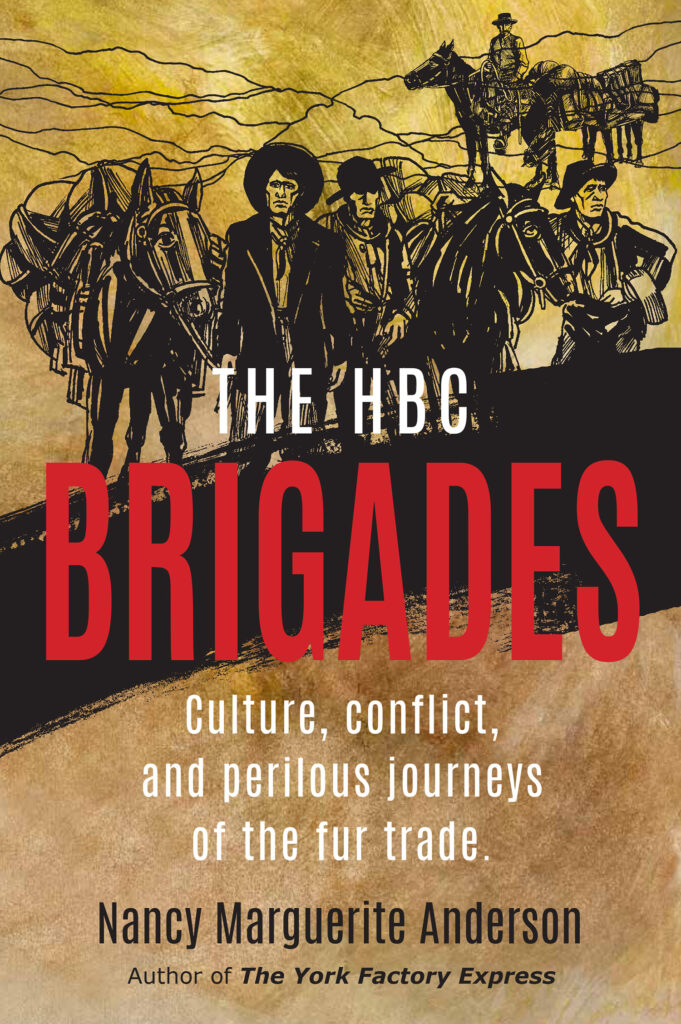
The HBC Brigades: Culture, Conflict and Perilous Journeys in the Fur Trade
Review By George Colpitts
November 5, 2024
BC Studies no. 223 Autumn 2024 | p. 129-130
Nancy Marguerite Anderson offers a detailed analysis of early trails and river routes supporting the British Columbia fur trade in The HBC Brigades: Culture, Conflict and Perilous Journeys in the Fur Trade. The book complements the author’s 2021 work, The York Factory Express: Fort Vancouver to Hudson Bay, 1826 -1849. In her latest book, Anderson focusses on the transport challenges facing the Hudson’s Bay Company (HBC) in British Columbia, especially after the consolidation of companies in 1821 and the decision to firm up a Pacific coastal link with the HBC’s interior posts, especially those of the distant northern interior plateau at Fraser’s Lake and Stuart’s Lake.
British Columbia was not a canoe frontier. Rather, company business largely came to depend on horse brigades. Though pieces of the company’s transport system relied on the flat-bottomed batteaux plying sections of the Fraser River, it turned to horses to pack goods in and furs out. Many brigades were organized as they were in 1826: a chief trader with two clerks led 24 men and 68 pack horses. These were divided into 12 smaller brigades that moved together but autonomously under the leadership of two men each. Interior horse encampments provided hundreds of the smaller, unshod, brigade horses to keep up these annual brigades. Many horses did not survive the rigors and mountainous terrain they endured in a single year’s work.
The book captures the endless ways that middle managers of the trade — post chief traders — sought to improve brigade routes. The first old brigade trail pioneered by John Stuart in 1813 gave way to a better route discovered in 1826 by William Connolly, using the Thompson Plateau to connect brigades to the “North River”, or Thompson River. Major innovations followed in the 1840s, especially to better connect Fort Langley and Kamloops. The clerk-in-charge of Fort Alexandria, A.C. Anderson, blazed a trail in 1846, later the Harrison-Lillooet Trail, that moved brigades travelling to Kamloops from a point higher on the Fraser. Outward travelling brigades the next year followed another route using the perilous banks of the upper Fraser, while those returning used the Anderson River, Utzlius Creek and Coldwater Rivers, departing the Fraser River around where Fort Yale was briefly established in 1848. But the system switched to favour a point on the Lower Fraser where Fort Hope was built (1848-49). The 1849 route, becoming the Fort Hope Trail, used a section of the Coquihalla River valley to go overland through passes and plateaux traversing the Tulameen River valley.
Significant to all this history were Indigenous politics, interests, and personalities. There are the Secwepemc who guided and provisioned trail blazers from Kamloops Lake, and the Stö:lō, connected to Fort Langley, who possessed superb mountain knowledge. N’Kuala (Hwistesmetxöquen, or Walking Grizzly Bear), chief of the Okanagan people, not only met and guided, but also protected, brigades passing through the Okanagan valley. Black-eye, an Upper Similkameen chief and his sons long accompanied brigades, and Black-eye offered critically important information to improve the company’s trail system. Brigade travel, provisioning, and infrastructure needs ultimately depended on HBC “communities” joining the interests of newcomers (HBC managers and servants, Métis labourers, and Canadians) and First Nations, the latter maintaining different relationships with the HBC and the fur trade.
Anderson’s book reminds readers that the HBC’s business in British Columbia was both in fur and brigade work. The book’s detailed maps will delight readers familiar with current BC topographical points and highway systems. They reveal the ways that the HBC’s own arduous development of viable transport systems laid the basis of trail and road networks that supported British Columbia’s colonial history after the great Gold Rush of 1858.
Publication Information
Anderson, Nancy Marguerite. The HBC Brigades: Culture, Conflict and Perilous Journeys in the Fur Trade. Vancouver: Ronsdale Press, 2024. 280 pp. $24.95 paper.
